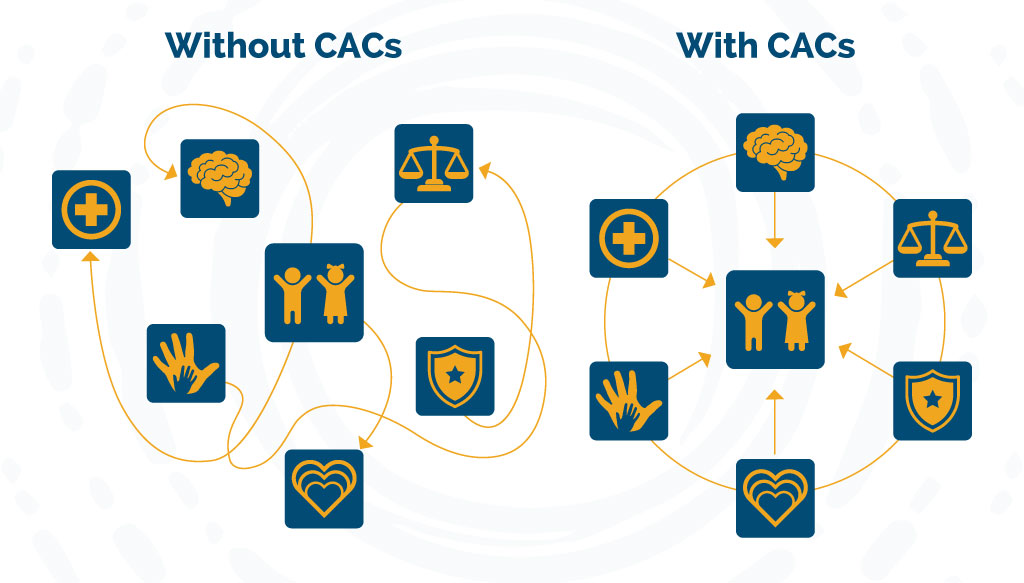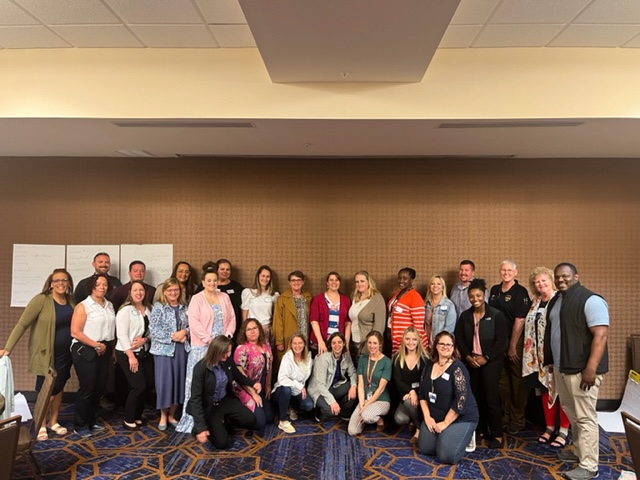Multidisciplinary Team Serves as the Heart of CAC Approach

This is part of an ongoing series featuring community members and organizations that partner with One Place and its Child Advocacy Center to fight child abuse. This entry focuses on the Multidisciplinary Team that works with the CAC to provide advocacy, treatment, and a protective umbrella for families.
At the heart of the One Place Child Advocacy Center’s commitment to protect and serve victims of child abuse is a team that is mandated by law but depends on an unqualified spirit of cooperation to succeed.
That group of investigators, child advocates and other experts is called the Multidisciplinary Team, or MDT. It is comprised of representatives from every law-enforcement agency in Onslow County, as well as members involved in prosecution, mental health, child advocacy, medicine, child-protective services, and other disciplines. The goal of the MDT is to respond quickly to concerns of child abuse and determine the best response for the child and family. The collaboration with the CAC reduces the number of times a child has to speak about their abuse, helps families access services, and encourages safety and healing for children and families.
Focus on the Child
CAC Director Kathleen Holbrook said the Multidisciplinary Team allows the center to function; without the work of all the partners, the mission of serving children would be incomplete. “We are not able to provide a service to children without our MDT partners,” she said. “None of us work independently on these cases; we do it as a team, which benefits the child and the family involved.”
Jacksonville Public Safety Director Mike Yaniero said recovery for the child is the overriding reason for this approach. Yaniero, who serves as Jacksonville’s police chief, was instrumental in bringing oversight of the multidisciplinary process to the CAC. He now chairs One Place’s volunteer board of directors.
“The Multidisciplinary Team starts the healing process,” Yaniero said. “It allows everyone who becomes involved with the child to come together and determine what is best for the child.”
While investigators and prosecutors can glean information from the interactions with the child, that is not what motivates this approach. “The purpose of it is to make sure the child isn’t revictimized by telling their story over and over,” he said. “The real purpose of the Multidisciplinary Team is to focus of the victim and to restore their innocence, basically.”
Holbrook said maintaining focus on the child promotes cooperation among team members. “We all have the same mission,” she said. “We may approach it from a different perspective because we have our own individual disciplines, and we have a different lens on it given our different professions and experiences, but ultimately our focus is on the child and the best possible outcome.”

The Process Starts Early
When there is a report of child abuse, whether received by law enforcement or generated by a medical situation or a social-services inquiry, the agency involved in the contact makes a call to initiate the involvement of the CAC and the MDT. “You’ve got a child who has been abused—sexual or physical abuse or trafficking—the investigator will contact us to request an evaluation because we are service providers, we are not investigators,” Holbrook said.
“Child Protective Services and the investigator will come here with the child, and they are part of the entire process,” Holbrook said. “They talk to us about the investigation. They observe the entire interview taking place.”
The forensic interviewers are part of a team of three specially trained staff members at the CAC. “These are very specialized child interviews where you can ask no leading questions,” she said. Trained professionals conduct the interviews in a child-friendly environment at One Place, and the interactions are observed in a separate room by law enforcement and other necessary parties.
Another step in the process is a comprehensive medical exam from CAC’s two-person staff of nurse practitioners who are registered with the state as child-abuse specialists. The CAC added the second examiner in January 2022.
Currently, there is only one examination room at One Place, but the non-profit agency’s efforts to secure funds for a new facility call for expansion of space for interviews and exams, with privacy being a primary concern. If a child suspected of being abused shows up at a hospital emergency room, the CAC is contacted so the exam can be conducted by its trained staff and the multidisciplinary process can begin.
On a rare occasion, maybe once a year or less, a parent or caregiver may express reservations about involving the CAC. Law enforcement will press for the process to be completed. “We are the child experts in the community,” Holbrook said. “If parents are saying ‘nothing happened to my child,’ the investigators will say, ‘Then the people at the Child Advocacy Center will be able to determine that.’”
The CAC also has advocates on staff whose job is to link the child and the family with other community resources that may be needed. “They follow up with the family after the appointment, and they accompany them to court should there be criminal charges,” Holbrook said.
According to information collected by the organization Children’s Advocacy Centers of North Carolina, 98 percent of multidisciplinary team members report the CAC process “resulted in more collaborative and efficient case investigations.” Similarly, 97 percent of caregivers reported “the CAC facilitated healing for the child and caregiver.”
The Multidisciplinary Process
The Multidisciplinary Team has several components that are active at various stages of an investigation and follow-up treatment. The full team meets monthly to review cases, while the heads of participating agencies hold periodic separate meetings. The CAC assembles a modified team to participate directly in cases.
The roster of modified team members depends on the individual cases, particularly regarding jurisdictions. Every case that comes to the CAC is assigned a separate modified team, and no case can be managed without one. All cases, about 300 per year, are referred from law-enforcement or child-protective services partners. “Those children must be part of an open investigation in order for us to get involved,” Holbrook said.
Members of a modified team usually includes representatives of all the disciplines that are part of the overall team. “They are present for four hours at a time when the child is here,” Holbrook said. “They sit together in a team room, and they talk the entire time. They watch the interview take place. They are hearing from the (medical professionals) about their findings, and they are hearing from the advocates about what their concerns may be. Together as a team, they make recommendations.”
The full Multidisciplinary Team takes up case reviews monthly, often meeting at the Sheriff’s Office. After receiving details in advance, team members review each case in a structured format, first looking to see if they have had any dealings with the children and families involved. They also will determine if there are services their agencies can offer.
The National Children’s Alliance produces an annual guide for how the business of a multidisciplinary team must be conducted to allow a Child Advocacy Center to remain accredited.
Holbrook said the CAC, working through the various components of the Multidisciplinary Team, is not intended to establish guilt or innocence but to sort out evidence to help determine what has happened to a child and what treatments may be available. What happens next is a distribution of information and services.
“The importance of the service for the community is that this is a one-stop-shop,” Holbrook said. “In the past, children had to go all over the place.” Now, the various stops in the hub of response to a report of abuse come to the child.
After the Multidisciplinary Team is involved in a case, the participating components—law enforcement, prosecution, social services, medical professionals, and child advocates—can return to their respective roles and responsibilities with the realization they are part of a coordinated, efficient response.
And children are better protected and better served. They gain exposure to all the resources a community has to offer. If a case goes to court, there are more legal assurances that a situation has been handled correctly by trained professionals operating within their field of expertise.
“If you do not interview a child in a particular way, following the child forensics model, you can ruin the whole thing,” Holbrook said in providing one example. “If you’ve got someone who is asking leading questions like, ‘Your Uncle Johnny did that to you, didn’t he?’ If you start asking questions like that, you have eliminated any potential of getting criminal charges.”
Through early involvement, the Multidisciplinary Team can serve as a springboard for investigators. A more solid case is built because each situation is being handled the same way, with professionals acting within their fields of expertise. Interactions between the various disciplines responding to a child’s needs are improved and can be made even better through training.
The Participants
The existence of the Multidisciplinary Team is established in a general order signed by the chief district judge under Chapter 7B of North Carolina’s General Statutes. The order requires designated agencies to share “information that is in their possession that is relevant to any assessment of a report of child abuse, neglect or dependency…” whenever a petition is filed alleging that a juvenile is abused, neglected, dependent, undisciplined or delinquent. Information restricted by federal law or held in the possession of the district attorney can be exempted.
The order also protects the privacy of the information, requiring that it remain confidential and released only in accordance with the federal Family Educational Rights and Privacy Rights Act.
The agencies listed in the current order include: Onslow County Department of Social Services; Onslow County District Attorney; Onslow County Schools Administrative Unit; Onslow County Sheriff’s Office; Jacksonville Police Department; North Topsail Beach Police Department; Holly Ridge Police Department; Provost Marshal’s Office, Criminal Investigation Division, Camp Lejeune-New River; Richlands Police Department; Surf City Police Department; Swansboro Police Department; Naval Criminal Investigation Services; State Bureau of Investigation.
Also, Child Advocacy Center of Onslow County, Onslow County Partnership for Children (now One Place); Let’s Talk; Serenity Behavioral Therapies; TEDI BEAR Children’s Advocacy Center; Bay Area Psychology Associates; Onslow County Health Department; Naval Medical Center, Camp Lejeune; Family Advocacy Program, Camp Lejeune-New River; Onslow Memorial Hospital; Legal Services Support Team, Camp Lejeune; Behavioral Health Program, Camp Lejeune-New River; the Office of the Guardian ad Litem Services; Onslow County court officials; Vidant Health Center; and East Carolina University Brody School of Medicine.

MDT April 2022 Retreat
Click here for more information on the One Place Child Advocacy Center.
